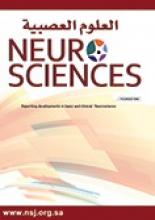Abstract
OBJECTIVE: To compare awake craniotomy using conscious sedation technique versus conventional general anesthesia (GA) for excision of low-grade glioma encroaching on eloquent brain.
METHODS: This prospective study included 40 patients ASA classification 1 and 2, aged 23-55 years, harboring low-grade glioma encroaching on eloquent brain. The study was carried out in the Neurosurgical Theatre in Kasr El-Aini Hospital, Cairo, Egypt, from January 2007 to November 2008. Twenty patients (group 1) received GA with endotracheal intubation and controlled ventilation. In group 2, awake craniotomy was carried out using local anesthetic infiltration, and intravenous injection of propofol and fentanyl.
RESULTS: Forty patients completed the study. In the awake group, none of the patients received GA, 2 patients developed intraoperative agitation, 5 patients were over-sedated, and none of the awake patients developed intraoperative nausea or vomiting. Four patients in the GA group developed post-operative nausea and vomiting compared to one patient in the awake group, and this difference was statistically significant (p=0.039). The neurological outcome regarding motor power and/or speech was found better or with no fresh deficits, immediately postoperative in 90% of the awake group patients. This is compared to 40% in the GA group. The difference was statistically significant. At 6 months follow up, the results were 90% and 60%, but the difference was not statistically significant. Gross total tumor resection was achieved in 10 cases of the GA group versus 8 in the awake group; however, the difference was not statistically significant.
CONCLUSION: Compared to GA, awake craniotomy is a relatively simple non-expensive procedure that allows tumor removal guided by physiology rather than anatomy.
- Copyright: © Neurosciences
Neurosciences is an Open Access journal and articles published are distributed under the terms of the Creative Commons Attribution-NonCommercial License (CC BY-NC). Readers may copy, distribute, and display the work for non-commercial purposes with the proper citation of the original work.






